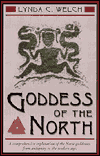
A reader seeking introduction to Norse Paganism will find this book an accessible introduction. The author expends a great deal of time and detail on Norse mythology, and history, pointing out how many myths praised the qualities of warrior women and myths that did not mention the Goddesses in now way indicated the absence of the Goddess. A more knowledgeable reader may, however, differ on how the usefulness of the book, depending upon personal experience regarding Norse tradition. For those new to the Norse, Goddess of the North gives a good compass about its tradition of Paganism. Welch divides her book into four sections: Historical Explanations, Fragments, Unveiling the Hidden Truth and Past to Present. Historical Explanations establishes context for Norse belief systems while tracing women’s changing influence. Welch supplies alternate historical perspectives and conclusions about women in Norse tradition through an examination of the myths and archaeological record. The Fragments portion gives insight into the texts that reveal what modern people know about the Vikings and their cultures, including maps and helpful illustrations. Welch added a particularly interesting chart of different Norse deities and their attributions determined by an early scholar on Norse history as a comparison to her own chart with conflicting conclusions. Unveiling the Hidden Truth explains notable absences of women in significant passages throughout the Norse mythologies and draws conclusions about the involvement of the Goddesses, based upon previous myths. Past to Present incorporates Norse tradition into the modern world. Goddess of the North has excellent research, and Welch supports her opinions well with documented facts. The table of contents suggests that Welch intends this book as an argument about the position of the goddess in Norse culture. She certainly proves that indeed female deity forms a very-present influence, supporting herself well through mythological, historical and archaeological evidence. The historical research appears reasonably accurate, although she presents a few debate-able conclusions about why social changes occurred as fact. The extensive bibliography lists books beyond the Norse; she drew information from shamanism, Islam and mainstream Paganism as part of her work. While some sources listed seem dubious, Welch balances them out with highly reputable sources. The alphabetic lists of Norse goddesses included as chapters actually help the reader as she delves deeper into mythology, establishing early on a working knowledge of Norse mythology and her inclusion of diagrams and pictures were useful ways to illustrate her points. Welch presents her case convincingly. Welch’s book is clearly intended for a mature audience seriously interested in Norse mythology. While in some areas she takes a personal approach to the reader, this book itself is not meant as light reading or simple inspiration. A reader can sense her seriousness particularly in her exploration of Norse ethics and their evidence in folk tales and mythology. The book appears reasonable, intelligent and worth a thorough read by anyone interested in Asatru. ~review by Diana RajchelAuthor: Lynda C. WelchRed Wheel/Weiser, 2001. $18.95
